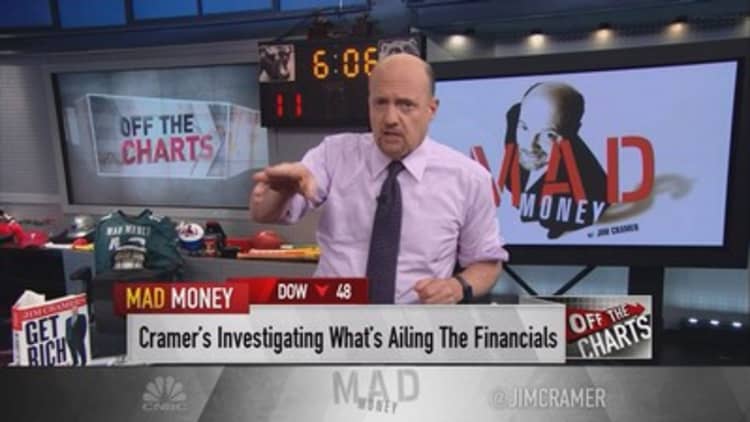
With the major indices trading near all-time highs and investors looking ahead to next week's Federal Reserve meeting in which the central bank is expected to raise interest rates, Jim Cramer figured the bank stocks would be rallying.
"Yet the bank stocks are not on fire here. They're actually lagging the rest of the market," the "Mad Money" host said.
To find out what is keeping the banks from climbing, Cramer took to the charts of technician Ed Ponsi, managing director of Barchetta Capital Management and Cramer's colleague at RealMoney.com.
First, Ponsi tracked the daily chart of the S&P Select Financial SPDR ETF, or XLF, which is widely accepted as one of the best bellwethers for the financials, against the SPDR S&P 500 ETF.
Because so many large bank stocks are in the , Ponsi said it would be unusual for the financial ETF, represented by the red line, to diverge from the rest of the index, pictured above in green.
Since the two diverged on May 15, the S&P made a series of higher highs, eventually seeing record highs, while the financial index saw progressively lower highs.
"How does Ponsi explain this action? In part, he thinks it's possible that investors are selling their bank stocks in order to pour money into sexier sectors like software, semiconductors, cloud, tech titans like Amazon and Alphabet, and I say who can blame them?" Cramer said.
But on a closer look at the individual chart of the financial ETF itself, Ponsi discovered a glaring technical problem as well: Cramer's dreaded head-and-shoulders pattern.
The formation, which resembles a head and shoulders, indicates that if the XLF, which is now trading just above $23, broke below the "neckline" at $22.90, the stock could fall 10 percent down to $21.
While Ponsi warned investors to be wary, he did not signal panic. Cramer noted that the $22.90 level was already tested twice, once in April and once in May, and held.
"Once again, the XLF was bailed out by dip buyers who took advantage of the broader stock market's weakness," Cramer said. "And that's Ponsi's point. While the financials don't seem to be getting much lift from the strength of the stock market, it's certainly kept them from breaking down."
To prove this point, Cramer turned to the chart of the aforementioned S&P ETF, which showed two moments, in April and May, when the market bottomed after a short decline only to soar higher afterwards. Ponsi argued that those moments prevented the banks from falling off a cliff.
"Unfortunately, he says the strength in the broader market is probably the only reason why the bank stocks haven't totally cratered. He's not saying the bank stocks should be shorted, although I'm sure some of you out there will do that, but he does think the group has a real problem," the "Mad Money" host said.
So while banks were the early gainers of the Trump rally, Cramer has since watched them sit back and mull over their gains as White House promises of major deregulation seem to fade.
"But here's the bottom line: while the charts, as interpreted by Ed Ponsi, suggest we need to be cautious about the banks here, I think that much will be forgiven if the Fed bites the bullet and tightens next week, and the financials will get a second wind. But if for some reason the Fed hesitates or goes soft about the next hike, then Ponsi will look like a genius, and the bank stocks? They'll get clobbered," Cramer said.
Watch the full segment here:

Questions for Cramer?
Call Cramer: 1-800-743-CNBC
Want to take a deep dive into Cramer's world? Hit him up!
Mad Money Twitter - Jim Cramer Twitter - Facebook - Instagram - Vine
Questions, comments, suggestions for the "Mad Money" website? madcap@cnbc.com



